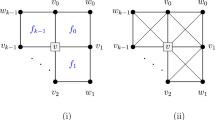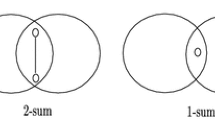Abstract
The max-flow problem in planar networks with only edge capacities has been proved to be in NC (Nickle's Class). This paper considers a more general version of the problem when the nodes as well as the edges have capacities. In a general network, the node-edge-capacity problem can be easily reduced to the edge-capacity problem. But in the case of planar network this reduction may destroy the planarity, and reduces the problem to the edge-capacity problem in a general network, which is P-complete. A recent contribution presents a new reduction for planar networks, that maintains the planarity. In this paper, it is proved that this reduction is in NC and thus the node-edge-capacity problem in undirected planar networks is in NC.
Similar content being viewed by others
Explore related subjects
Discover the latest articles, news and stories from top researchers in related subjects.References
Ahujia R K, Magnanti T L, Orlin J B. Network Flows: Theory, Algorithms and Applications. Prentice-Hall, New Jersey, 1993.
Weihe K. Maximum (s, t)-flows in planar network inO(|V|log|V|) time.J. Computer and System Sciences, 1997, 55(3): 3–23.
Goldberg A V, Tarjan R E. A new approach to the maximum flow problem.J. Assoc. Comput. Mach., 1988, 35(4): 921–940.
Goldberg A V. Recent developments in maximum flow algorithms (Invited Lecture). InProc. Sixth Scandinavian Workshop on Algorithm Theory, Stockholm, Sweden, July, 1998, pp.1–6.
Johnson D B. Parallel algorithms for minumum cuts and maximum flows in planar networks.J. Assoc. Comput. Mach., 1987, 34(4): 950–967.
Goldschlager L M, Shaw R, Staples J. The maximum flow problem is log space complete.Theoretical Computer Science, 1982, 21(1): 105–111.
Bondy J A, Murty U S R. Graph Theory with Applications. North-Holland, Amsterdam, 1977.
Zhang X C. Study on algorithms for the maximum network flow problem [dissertation]. University of Science and Technology of China, Hefei, China, 2001. (in Chinese)
Chen G L. Design and Analysis of Parallel Algorithms. Higher, Education Publishing House, Beijing, China, 1994. (in Chinese)
Zhang X C, Wan Y Y, Chen G L. Approaches to the minimum cut problem in a class of practical networks.Journal of Software, 2003, 14(5): 885–890. (in Chinese)
Chen G L, Liang W F, Shen H. Research advances in parallel graph algorithms.Computer Research and Development, 1995, 32(9): 1–16. (in Chinese)
Author information
Authors and Affiliations
Corresponding author
Additional information
Supported by the National Basic Research 973 Program of China under Grant No.G1999032700.
Rights and permissions
About this article
Cite this article
Zhang, XC., Wan, YY. & Chen, GL. Max-flow problem in undirected planar networks with node capacities being in NC. J. Comput. Sci. & Technol. 19, 787–790 (2004). https://doi.org/10.1007/BF02973440
Received:
Revised:
Published:
Issue Date:
DOI: https://doi.org/10.1007/BF02973440




